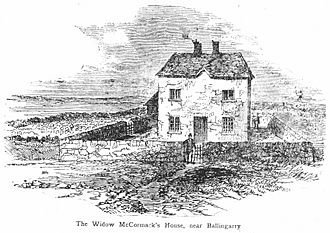Famine Warhouse 1848 facts for kids
Quick facts for kids Famine Warhouse 1848 |
|
|---|---|
|
Teach Cogaidh Bhaile na Gharraí
|
|

Engraving from Michael Doheny's The Felon's Track (1849)
|
|
| Alternative names | Ballingarry Warhouse The Widow Margaret McCormack's House |
| General information | |
| Status | Museum |
| Type | Farmhouse |
| Architectural style | Vernacular |
| Location | Farranrory Upper |
| Town or city | Ballingarry |
| Country | Ireland |
| Coordinates | 52°37′09″N 7°31′22″W / 52.619273°N 7.522898°W |
| Elevation | 292 m (958 ft) |
| Technical details | |
| Material | Stone, slate |
| Floor count | 2 |
| Designations | |
| Official name: Ballingarry Warhouse | |
| Designated: | April 1989 |
| Reference #: | 659 |
| Known for | Battle site |
The Famine Warhouse 1848 is a famous old farmhouse in Ireland. It is also known as the Ballingarry Warhouse. This house is special because a small but important battle happened here in 1848. This event was part of the Young Irelander Rebellion. It was also the first time the Irish tricolour (the national flag of Ireland) was flown!
The house is located about 4 kilometers (2.5 miles) north of Ballingarry, South Tipperary. In 1848, it belonged to Margaret McCormack, a widow.
Contents
What is the Famine Warhouse?
The Famine Warhouse 1848 is a historic farmhouse. It is famous for a short but important fight that took place there. This event was part of a bigger movement for change in Europe. The house is now a museum. It teaches visitors about the Great Famine and the rebellion.
The Young Irelander Rebellion of 1848
In 1848, many parts of Europe saw people rising up for change. This time was called the "Springtime of the Peoples." Ireland also had its own uprising, led by a group called the Young Irelanders. They wanted Ireland to be free from British rule.
The leader of this rebellion was William Smith O'Brien. On July 29, 1848, O'Brien and his followers gathered at the Widow McCormack's house. They found 47 policemen from the Irish Constabulary (a police force at the time) inside.
The Battle at the Warhouse
The rebels tried to get the police to surrender. A tense standoff happened. During the fight, two people from the rebel side were hurt. The rebels then decided to leave.
After the battle, many rebels, including William Smith O'Brien, were caught. They were sent away to live in other countries, like Australia. Some of them later managed to escape to the United States.
The First Irish Tricolour
A very important moment happened at the Famine Warhouse. It was the first time the Irish tricolour was flown. This flag has three colors: green, white, and orange. It is now the national flag of Ireland.
From Farmhouse to Museum
Locally, the house was always known as the Warhouse. In 1989, it became a National Monument. This means it is a protected historical site. The house was fixed up in 2000 and 2001. In 2004, it was officially renamed "Famine Warhouse 1848."
Today, the Famine Warhouse is a museum. It has exhibits that tell the story of the Great Famine. This was a terrible time when many people in Ireland suffered from hunger. The museum also shows how many Irish people had to leave their homes and move to other countries. You can also learn about the 1848 rebellion and what happened to its leaders.

